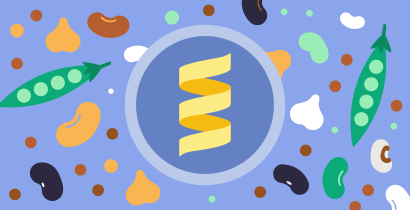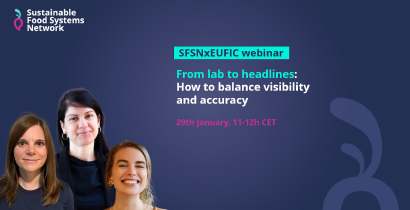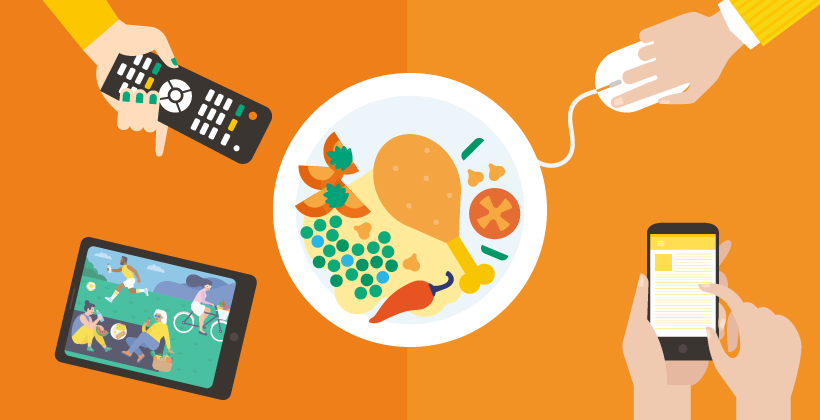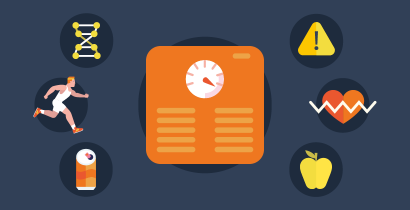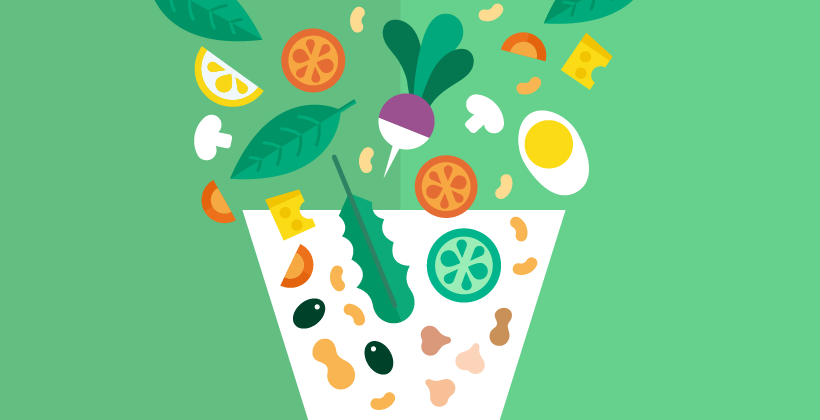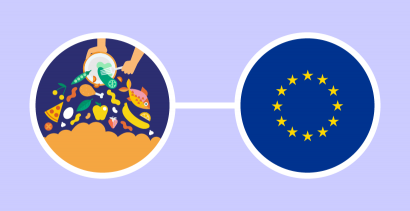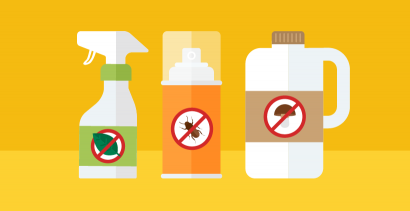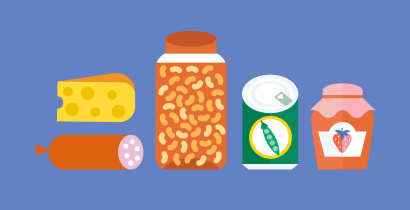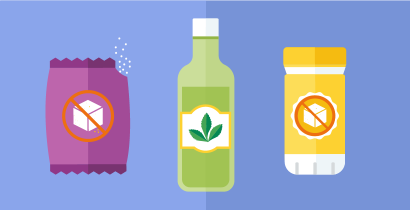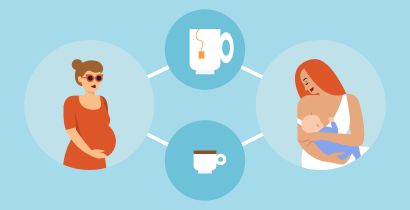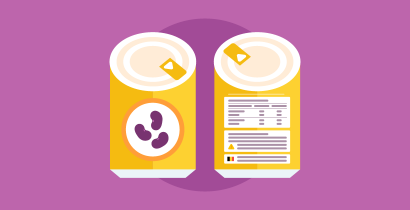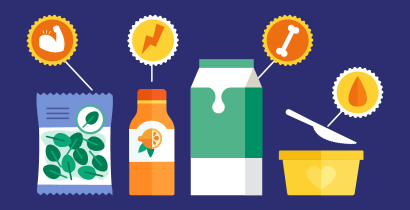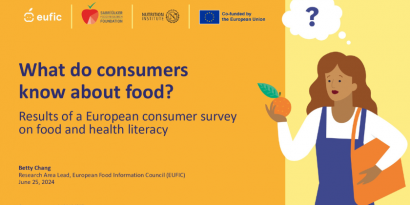Search results for .
Consumer Research: Insights for healthier and more sustainable choices
Found in 26 February 2025What are the main gaps in consumers’ food and nutrition knowledge? Which types of interventions are more promising in reducing the risk of chronic diseases? What information do consumers want to know to eat more healthily and sustainably? Which factors determine how much food consumers waste? These are only some…
Fact-checking resources
Found in 25 February 2025Whether you want to fact-check a claim or sharpen your media literacy skills, this page is your trusted guide to verify science-based information.
Debunking myths
Found in 25 February 2025While debunking myths is part of our work, prevention is just as critical. It’s all too easy to get lost in the sea of diet trends, fads, and conflicting advice. This section breaks down popular food and health claims providing clear, concise, and evidence-based information to help consumers make informed…
Bisphenol A: What is it, its health effects and should we avoid it?
Found in 25 February 2025Picture this: you just finished a delicious meal, and in a fight against food waste, you are eager to store your leftovers in a convenient plastic container. Most plastics these days are labelled ’BPA-free’; but what exactly does this mean and why does it matter? This article explores what BPA…
Oligosaccharide
Found in 25 February 2025Oligosaccharide sind eine Art von Kohlenhydraten, die aus einigen wenigen, meist aus 3 bis 10 miteinander verbundenen Zuckermolekülen bestehen. Oligosaccharide können vielerlei Funktionen haben, darunter Zellerkennung und -adhäsion.
Immunglobuline
Found in 25 February 2025Immunglobuline, auch als Antikörper bezeichnet, sind Proteine, die vom Immunsystem produziert werden, um den Körper bei der Abwehr von Krankheitserregern wie Bakterien, Viren und Toxinen zu unterstützen.
Fettgewebe
Found in 25 February 2025Fettgewebe ist ein Bindegewebe, das hauptsächlich aus Fettzellen besteht. Es spielt eine wichtige Rolle bei der Energiespeicherung, der Thermogenese und dem Stoffwechsel im Körper.
Mikrobiota
Found in 25 February 2025Eine Gemeinschaft von Mikroorganismen in einer bestimmten Umgebung.
Oligosacáridos
Found in 25 February 2025Los oligosacáridos son un tipo de carbohidrato formado por una pequeña cantidad de moléculas de azúcar unidas entre sí, normalmente entre 3 y 10. Los oligosacáridos pueden tener muchas funciones, entre ellas el reconocimiento y la adhesión celular.
Inmunoglobulinas
Found in 25 February 2025Las inmunoglobulinas, también conocidas como anticuerpos, son proteínas producidas por el sistema inmunitario para ayudar al organismo a defenderse de patógenos como bacterias, virus y toxinas.
Tejido adiposo
Found in 25 February 2025Los tejidos adiposos también se conocen como tejido graso. Se trata de un tejido conjuntivo compuesto principalmente por células adiposas que desempeñan distintas funciones en el almacenamiento de energía, la termogénesis y el metabolismo del organismo.
Immunoglobulines
Found in 25 February 2025Les immunoglobulines, également appelés anticorps, sont des protéines produites par le système immunitaire afin d’aider le corps à se défendre contre des agents pathogènes telles que des bactéries, des virus et des toxines.
Tissu adipeux
Found in 25 February 2025Les tissus adipeux sont également connus sous le nom de tissu graisseux. Composé essentiellement de cellules graisseuses, ce tissu conjonctif joue un rôle dans le stockage de l’énergie, la thermogénèse et le métabolisme du corps.
Microbiote
Found in 25 February 2025Ensemble de micro-organismes vivant dans un environnement particulier.
Oligosaccaridi
Found in 25 February 2025Gli oligosaccaridi sono un tipo di carboidrato costituito da un piccolo numero di molecole di zucchero legate tra loro, di solito tra 3 e 10. Gli oligosaccaridi possono avere molte funzioni, tra cui il riconoscimento e l’adesione cellulare.
Immunoglobuline
Found in 25 February 2025Le immunoglobuline, note anche come anticorpi, sono proteine prodotte dal sistema immunitario, le quali aiutano l’organismo a difendersi da agenti patogeni come batteri, virus e tossine.
Tessuto adiposo
Found in 25 February 2025I tessuti adiposi sono noti anche come tessuto grasso o grasso corporeo. Si tratta di un tessuto connettivo composto principalmente da cellule adipose, che svolgono un ruolo distinto nell’immagazzinamento dell’energia, nella termogenesi e nel metabolismo del corpo.
Deep dives
Found in 24 February 2025A mix of interviews and webinars taking a closer look into complex food and health topics and their representation in the media with insights from researchers and media professionals.
Media reactions
Found in 24 February 2025Whenever a new food study comes out, headlines may vary wildly with claims of alleged new links to health issues – misrepresenting scientific evidence, lacking context or oversimplifying complex issues. But what does the research actually tell us? We break down the story and share our briefings widely.
Misinformation
Found in 24 February 2025Access to accurate, science-backed information is essential for making healthier choices and improving public health across Europe. Misinformation, however, can distort public understanding and decision-making. At EUFIC we are committed to enhancing food and health literacy by improving the quality of nutrition and food safety coverage in both traditional and…
Ultra-Processed Foods: Consumer perspectives and innovative solutions
Found in 19 February 2025Ultra-processed foods (UPFs) are a pressing issue in public discourse—from health concerns to policy discussions—but what do EU consumers really think? On January 31, 2025, we hosted a dynamic webinar to explore how consumers deal with the UPFs classification, bringing together 9 top experts and over 500 attendees. This engaging…
Which pulses are high in protein?
Found in 10 February 2025Gone are the days when people assumed protein only came from meat, dairy, and eggs. Whether you are following a vegetarian or vegan diet or simply want to increase your intake of plants, pulses can make a great protein-packed ally. From lentils and chickpeas to black beans and peas, there…
€80M EU-funded Projects Launch Unprecedented Collaboration to Address the Obesity Crisis in Europe
Found in 06 February 2025Brussels, February 6th, 2025 – Over the past decades, obesity has reached epidemic proportions, now affecting more than 1 billion people worldwide. Childhood obesity, in particular, is rising at an alarming rate. According to the World Obesity Federation, the number of children with obesity is expected to double between 2020…
Microbes4SustainableFoods Cluster Secures €45M+ in EU Funding to Drive Innovation in Sustainable Food and Health
Found in 05 February 2025Brussels, February 5th, 2025 – As the global appetite for sustainable food options continues to grow, microbiome-based innovations such as fermented foods are emerging as a powerful tool for improving human health and protecting the environment. Leading the charge in Europe is the Microbes4SustainableFoods (M4SF) Cluster, a collaboration of EU-funded…
neurocognitive disorders
Found in 03 February 2025A group of medical conditions characterised by a decline in cognitive abilities such as attention, executive function, learning and memory, language, motor skills, or social cognition. Examples of conditions include Alzheimer’s disease and vascular dementia.
Are processed meats linked to an increased dementia risk?
Found in 03 February 2025Recent news stories have reported that people who eat a lot of processed meat, such as bacon, pepperoni, and sausages, face a higher risk of cognitive decline and dementia. Most dietary guidelines already recommend eating little processed meat, if any. This is because they’re often high in salt, energy, fat,…
From lab to headlines: How to balance visibility with accuracy
Found in 29 January 2025Striking the right balance between visibility and accuracy remains a constant challenge for researchers and media professionals alike. So, on January 29th, EUFIC, in collaboration with the SFSN, hosted a webinar that brought together experts across the information pipeline to pull from recent media examples and offer insights into how…
Do seed oils promote oxidative stress?
Found in 24 January 2025Seed oils are oils extracted from the seeds of various plants. You’ll recognise them as rapeseed (or canola), corn (maize), cottonseed, grapeseed, soybean, sunflower, safflower, and rice bran oil. They’re affordable, have a high smoke point (meaning they are stable at high temperatures, which makes them suitable for frying), and…
Do seed oils cause inflammation?
Found in 24 January 2025Seed oils are oils extracted from the seeds of various plants. You’ll recognise them as rapeseed (or canola), corn (maize), cottonseed, grapeseed, soybean, sunflower, safflower, and rice bran oil. They’re affordable, have a high smoke point (meaning they are stable at high temperatures, which makes them suitable for frying), and…
Do seed oils cause chronic diseases?
Found in 24 January 2025Seed oils are oils extracted from the seeds of various plants. You’ll recognise them as rapeseed (or canola), corn (maize), cottonseed, grapeseed, soybean, sunflower, safflower, and rice bran oil. They’re affordable, have a high smoke point (meaning they are stable at high temperatures, which makes them suitable for frying), and…
Does the processing of seed oils pose a health risk?
Found in 24 January 2025Seed oils are oils extracted from the seeds of various plants. You’ll recognise them as rapeseed (or canola), corn (maize), cottonseed, grapeseed, soybean, sunflower, safflower, and rice bran oil. They’re affordable, have a high smoke point (meaning they are stable at high temperatures, which makes them suitable for frying), and…
Are food products with more than five ingredients unhealthy?
Found in 23 January 2025There’s a common myth that food products with more than five ingredients are automatically “unhealthy.” This belief stems from the idea that the more ingredients in a packaged food, the more highly processed or “unnatural” it probably is, and thus “worse” for our health. But that’s not necessarily the case.…
Debunking 10 common nutrition myths for 2025
Found in 20 January 2025Navigating the world of nutrition can feel like trying to find your way through a maze of myths and misconceptions. In particular - January is a month where people dive into the latest diet trends or try out new wellness routines. Before heading down misleading paths, we’re here to bust…
The role of lactic acid bacteria in food fermentation
Found in 16 January 2025The unique flavours, textures, and health benefits of fermented foods like yogurt, sauerkraut and sourdough bread come from a community of microorganisms that transform regular ingredients into something special. Among the key players in this process are lactic acid bacteria. So, what exactly are lactic acid bacteria, and how do…
Do plant-based milk drinkers have a higher risk of depression?
Found in 09 January 2025Recent news stories have reported that vegans who drink plant-based milk alternatives are at a higher risk of depression and anxiety, based on results from a new study by researchers in China . Conversely, people who drank semi-skimmed dairy milk were less likely to suffer from low mood and anxiety.…
Whole grain switch challenge urges people to improve their health – and the planet’s at the same time
Found in 24 December 2024Driving Sustainability in Food Retail: EIT Food SUCCESS Launched Toolkits to Empower Retailers and Consumers
Found in 11 December 2024The EU-funded EIT Food SUCCESS project launched two key outputs — a Retailer Toolkit and a Consumer Toolkit — during the final online symposium on 26 November 2024. These resources have been designed to help retailers and consumers adopt healthier, more sustainable food practices and promote conscious choices across Europe.…
Healthy eating for young adults (2024)
Found in 01 December 2024Communication about healthy eating is often targeted at those who are interested in eating healthily. But what about those who are less interested? To make sure no one is left behind, HEYA (Healthy Eating for Young Adults) was designed to investigate the food-related communication needs, preferences, and priorities of consumers…
INFOODMATION: Understanding media’s role in consumer’s food behaviour
Found in 27 November 2024INFOODMATION: Understanding media’s role in consumer’s food behaviour
Mindless to mindful eating
Found in 20 November 2024Eating mindlessly may be contributing to the ever-expanding waistlines across the globe. Research into mindful eating has largely focused on weight control and helping people to develop a better relationship with food. How can you eat more mindfully? Mindless eating A scientific review found that people who were given larger…
Oligosaccharides
Found in 19 November 2024Oligosaccharides are a type of carbohydrate made up of a small number of sugar molecules linked together, usually between 3 and 10. Oligosaccharides can have many functions including cell recognition and cell adhesion.
What is the role of gut bacteria in human health?
Found in 15 November 2024Your body is home to trillions of microorganisms, including bacteria, yeasts, and viruses, which live in various areas such as your skin, nose, mouth, and gut. Many of these microorganisms reside in your gut, and among these, the bacteria there play a particularly important role in regulating your health through…
EUFIC launches #SwitchToWholeGrains campaign to challenge consumers to switch to a healthier diet
Found in 29 October 2024Brussels, October 29th, 2024 – The European Food Information Council (EUFIC) is excited to launch its Switch to Whole Grains campaign with the support of the Whole Grain Initiative. The science-backed campaign takes place throughout the whole month of November, encouraging consumers to switch to whole grains as part of…
comorbidities
Found in 18 October 2024The presence of two or more medical conditions in an individual. These conditions can be linked through chance occurrence, overlapping risk factors, complications of one condition leading to another, or a third condition causing both.
years lived with disability
Found in 18 October 2024A measure of the impact a certain condition or disease has on quality of life before it resolves or leads to death. It represents the total years of healthy life that were lost due to ill-health related to having a specific condition or disease.
reduce life expectancy
Found in 18 October 2024The average number of years that a person can expect to live based on current mortality rates (age-specific death rates).
preeclampsia
Found in 18 October 2024condition that can happen during pregnancy where a woman has high blood pressure and signs that some organs, like the liver and kidneys, are not working normally.
osteoarthritis
Found in 18 October 2024A type of degenerative joint disease that results from breakdown of joint cartilage and underlying bone. It causes pain, swelling and stiffness, affecting a person’s ability to move freely. It is most common in the knees, hips, spine and hands.
meningioma
Found in 18 October 2024Cancer of the meninges, the membranous layers surrounding the brain and spinal cord.
multiple myeloma
Found in 18 October 2024Cancer of plasma cells, a type of white blood cells, in the bone marrow.
heritability
Found in 18 October 2024A measure of how much of the variation in a trait (like height, intelligence, or eye color) among individuals in a population can be attributed to genetic differences. It doesn’t tell us about any one individual, but rather explains how much genetics, as opposed to other factors like environment, influence…
skinfold callipers
Found in 18 October 2024An instrument to measure the thickness of a ‘pinch’ of skin and the fat beneath it in specific areas of the body. The trunk, thighs, front and back of the upper arm, and under the shoulder blade are commonly measured. Based on these measurements, calculations are used to estimate body…
bioelectrical impedance analysis
Found in 18 October 2024A method used to estimate body fat percentage and fat-free mass. It uses a small, safe electric current passed through the body, measuring resistance. The current faces more resistance passing through body fat than it does passing through lean body mass and water.
MRI scans
Found in 18 October 2024MRI (Magnetic Resonance Imaging) scans use magnets and radio waves to create detailed images of the inside of the body.
air-displacement plethysmography
Found in 18 October 2024A method used to estimate body volume based on air pressure differences between an empty chamber and an occupied chamber.
Overweight and obesity classification: BMI & other methods
Found in 18 October 2024Recent estimates suggest that about 880 million adults and 159 million children are living with overweight and obesity.1 But what does overweight and obesity mean? And how are they classified, and why should we care? Understanding these classifications is important for our health because they help us assess our risk…
Obesity: definition, causes and prevention strategies
Found in 17 October 2024Obesity is a multifactorial, chronic, relapsing, non-communicable disease marked by an abnormal and/or excessive accumulation of body fat that presents a risk to health. It is well established that obesity acts as a gateway to a range of other non-communicable and communicable diseases. This article further explores the causes of…
Europe’s obesity statistics: figures, trends & rates by country
Found in 17 October 2024Obesity is a complex, multifactorial disease, defined as abnormal or excessive accumulation of fat that poses a health risk.1 It has been recognised as a major public health concern and a significant contributor to death and disability. Obesity is a key risk factor in the development of many non-communicable diseases…
Zero Hidden Hunger EU Policy Lab to engage European policy makers in combatting micronutrient deficiencies in at-risk populations in Europe
Found in 15 October 2024Brussels, 15th October 2024 - The Zero Hidden Hunger EU project marks World Food Day (16th October) with the launch of a new Policy Lab, led by the European Public Health Alliance (EPHA). This initiative will bring together European policy makers to co-create policy solutions aimed at addressing the pressing…
What’s in your fridge? EUFIC launches interactive tool to decode food labels
Found in 15 October 2024Brussels, 15 October 2024 - Today, EUFIC launches its interactive food labelling resource, making it easier for consumers to understand nutrition labels and to make healthier choices while grocery shopping. The tool offers an engaging way to explore “your fridge” looking at key components of food labels—like serving sizes, calories,…
What’s Important for Vegetarians and Vegans to Eat?
Found in 14 October 2024Many people choose to exclude meat and other animal products from their diet for a variety of reasons and to varying extents. Whatever the reason, careful planning is needed to ensure adequate nutrient intakes. Avoiding deficiency ‘Vegetarianism’ encompasses a range of dietary patterns. Lacto-ovo-vegetarians eat dairy products and eggs, pesco-vegetarians…
Is soy good or bad for you? Here’s what the science says
Found in 14 October 2024Is soy good or bad for you? This question has been a subject of much debate and speculation. In recent years, soy has gained popularity as a versatile and nutritious food source. Soy and soy-based products have found their way into a wide range of foods, from tofu and soy…
Is eating soy bad for the environment?
Found in 14 October 2024Soybeans are a widely grown crop, known for its use in a wide variety of food products, Soy is also used to produce animal feed and for several other industrial purposes. In the last 50 years, soy production has expanded rapidly and has been scrutinised for its impact on the…
Protein Pioneers: Leading the Way in Alternative Protein Project
Found in 11 October 2024[Brussels, 11th October 2024] – Ahead of World Algae Day (12th October),the EU-Funded project InnoProtein will celebrate the occasion by launching the #ProteinPioneers initiative. Europe[GS1] faces a significant “protein gap,” importing 70% of its protein-rich crops and 85% of its soybeans for both animal and human consumption. With the global…
Positive impacts of personalized dietary advice based on socio-demographic and cognitive characteristics
Found in 07 October 2024Adiós a los alimentos podridos: ‘Método FIFO’, la mejor forma de ordenar tu nevera, adios a l
Found in 07 October 2024I’m a home expert & my six food storage tips will make your groceries last longer - it’ll save you so much money | The Sun
Found in 07 October 2024Valencia Hosts Capacity Building Event for Food Loss and Waste Prevention in Cities
Found in 02 October 2024Valencia, Spain, 8th October 2024 – The World Sustainable Urban Food Centre of Valencia (CEMAS) and the European Food Information Council (EUFIC) are proud to co-organise a high- impact event titled ‘Capacity Building for Food Loss and Waste Prevention and Reduction in Cities.’ The event, taking place at Edificio Veles…
EUFIC’s lab on sweeteners offers insight into consumer perceptions and roadmaps for better health communication
Found in 30 September 2024Acknowledging the need for transparent, science-based communication about the risks and benefits of sweeteners, EUFIC hosted a Communication Lab on Sweeteners on September 23rd. The webinar featured leading experts to discuss their latest research on sweeteners, their respective challenges and implications for health and nutrition. Stakeholder representatives were encouraged to…
The Future of Microbiome-Based Biomarkers: Human Microbiome Action announces publication in The Lancet Microbe
Found in 05 September 2024[Brussels, 5th September 2024] –The EU-funded Human Microbiome Action consortium conducted a Delphi survey, coordinated by the Pharmabiotic Research Institute (PRI), to establish a consensus on the needs, challenges and limitations in qualifying microbiome-based biomarkers. The study, published in The Lancet Microbe, highlights a strong confidence among experts in the…
Food waste in Europe: statistics and facts about the problem
Found in 30 August 2024Would you go into a supermarket, buy five shopping bags of food, and then immediately throw one away? Statistically, that’s what’s happening to our food today. Nearly one fifth of all the food that is available to us is wasted. When we waste food, we waste all the resources that…
Brooklands New Media publication on EUFIC’s 30th Anniversary not endorsed by EUFIC
Found in 20 August 2024Brooklands New Media has informed us that they will be publishing an independent, special commemorative publication celebrating 30 years of EUFIC. This special anniversary edition has not been solicited by EUFIC. It is published independently as a special industry tribute and is, therefore, not associated with, sponsored, or endorsed by…
Is glyphosate banned in the EU due to its harmful effect, or not?
Found in 05 August 2024In Europe and around the world, the safety and regulatory status of glyphosate, a commonly employed herbicide, remain subjects of ongoing debate. Despite its effectiveness in weed control and utility in modern agriculture, concerns persist about its presence in food and potential health risks. While conflicting conclusions emerge from studies…
Are pesticides harmful to humans and the environment?
Found in 05 August 2024As the population grows and agricultural land remains limited, it is important to ensure that farms are as productive as they can be. In modern agriculture, pesticides are critical for the productivity of farming systems and for safeguarding consumers from the ill effects of pest-damaged foods. However, if used in…
Provocation studies
Found in 05 August 2024Provocation studies involve deliberately inducing a response or reaction in research participants to observe and analyse specific behaviours or physiological changes. These studies aim to provoke a controlled reaction, providing insights into various aspects of human behaviour or physiological responses under specific conditions.
Food processing: understanding its methods, examples and importance
Found in 31 July 2024Walk into any supermarket and you can find a wide range of varied processed foods: from frozen fish filets in the freezer section, canned chickpeas over in the middle aisles, to freshly baked breads and pastries at the bakery counter. But what does the term food processing actually mean? And…
Caffeine levels in different foods and drinks
Found in 31 July 2024We all love our morning cup of coffee, and for good reason – caffeine, that magical compound that takes away our sleepiness and makes us wide awake. But do you know how much caffeine is in your cup of coffee? And how many cups of coffee are safe to drink…
Aspartame (Q&A): What is it and what foods contain this additive?
Found in 31 July 2024Available for over 30 years, aspartame is approved for use in more than 100 countries around the world. Aspartame is a very thoroughly tested food additive with a comprehensive body of studies conducted in animal models and humans. All of these studies demonstrate that aspartame is safe. The first European…
Sweeteners: Addressing Common Questions and Debunking myths
Found in 31 July 2024For centuries, various foods, like honey or sugar, have been used to sweeten our food. Today, we also have a range of new sweeteners, which provide low-calorie alternatives to sugar. The EU has established strict rules about which sweeteners may be safely used and what information must be included on…
Is caffeine good or bad for pregnancy and breastfeeding?
Found in 31 July 2024Caffeine is a stimulant naturally present in coffee, tea, chocolate, and certain plants, while it may also be added to energy drinks, colas, and certain sports and weight loss supplements. However, if you are pregnant or breastfeeding, you might need to reduce your daily intake of your favourite drinks and…
What does caffeine do to our body?
Found in 31 July 2024Caffeine is a natural stimulant that belongs to a class of compounds called xanthines. The most well-known source of caffeine is the coffee bean, the seed of the Coffea plant. Other natural sources include the tea leaf, kola nut, cacao pod, and guarana berries. Caffeine can also be produced synthetically…
Collaboration of European Projects Advances Personalised Solutions for Obesity
Found in 16 July 2024The urgency for immediate action in combating the global obesity crisis has never been more apparent. According to recent data, over 2.5 billion adults, representing a staggering 43% of the global population aged 18 years and older, are currently grappling with overweight issues. Additionally, a further 890 million individuals are…
MELIORA: transforming breast cancer risk reduction through innovative strategies
Found in 16 July 2024MELIORA: transforming breast cancer risk reduction through innovative strategies
What information can we find on food packaging?
Found in 10 July 2024Food labels serve as an essential communication tool between producers and consumers, providing a wealth of information that can empower us to make informed choices about the food we eat. Knowing how to read and understand these labels is key to having a healthy diet that fits our dietary needs…
What are nutrition and health claims?
Found in 10 July 2024In today’s health-conscious world, consumers are increasingly seeking information about the nutritional content and health benefits of the foods they consume. As a result, claims about certain properties of the food have gained prominence on food packaging. In the EU, three types of claims are allowed to be made on…
Food literacy survey in 7 European countries (2024)
Found in 05 July 2024In the context of our first long-term goal of building food and health science literacy, we conducted this survey to find out what consumers understood in this area, and where were their greatest knowledge gaps, so to better tailor our activities to address these gaps. European food literacy survey 2023-2024:…
Is dark chocolate good for weight loss?
Found in 28 June 2024Who doesn’t love to indulge in some dark chocolate every now and then? Dark chocolate is derived from the cocoa bean and often has a higher cocoa content compared to its milk chocolate counterpart. Cocoa is rich in flavanols, a type of polyphenol, which have been linked to various health…
Do carbohydrates make you gain weight?
Found in 28 June 2024Carbohydrates are the sugars, starches, and dietary fibres found in the foods we eat every day, such as fruits, vegetables, cereals, pulses, root crops, dairy, and sweeteners. Carbohydrates are broken down by our body into simple sugars (glucose and galactose) that are absorbed into the bloodstream and used as the…
Harnessing the power of microbiomes to improve our health: Launch of EU-funded MICROBIOMES4SOY
Found in 27 June 2024MICROBIOMES4SOY responds to the urgent call on World Microbiome Day to transition to healthier, more environmentally friendly, plant-based diets. The EU-funded Horizon project uses the soyabean crop as model system to deepen microbiome understanding and develop ambitious microbiome-based innovations in the food sector. Why microbiomes? Microbiomes, the diverse communities of…


